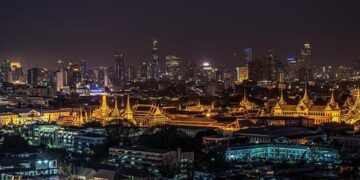As Thailand gears up for its beloved Loy Krathong festival, a time-honored tradition that illuminates waterways with vibrant floats and glowing lanterns, the government is taking significant steps to ensure that the celebration aligns with more sustainable practices. Authorities are urging both locals and tourists to adopt eco-friendly methods during this year’s festivities, emphasizing a collective responsibility to protect the environment while preserving cultural heritage. Amid growing concerns over pollution and environmental degradation, this initiative seeks to balance the joy of celebration with the urgent need for conservation. Khaosod English reports on the efforts and guidelines being implemented to make this year’s Loy Krathong not only a spectacle of beauty but also a commitment to sustainability.
Thailand Promotes Sustainable Loy Krathong Celebrations to Protect Aquatic Ecosystems
In light of the environmental challenges facing aquatic ecosystems, Thailand is taking a bold step forward by promoting sustainable practices for the Loy Krathong festival. This annual celebration, known for its vibrant lanterns and floating offerings, commonly leads to concerns about waste and pollution in local waters. To mitigate these issues, the government and environmental organizations are urging participants to adopt eco-friendly alternatives, such as biodegradable krathongs made from natural materials. These initiatives aim to preserve the delicate balance of marine life while allowing people to partake in the tradition responsibly.
Key measures being encouraged include:
- Use of Natural Materials: Participants are encouraged to create krathongs from banana leaves and flowers, avoiding plastics and synthetic materials.
- Community Clean-Up Events: Local organizations are organizing clean-up drives post-celebration to ensure that waterways remain clean.
- Awareness Campaigns: Educational programs are being launched in schools and communities to inform festival-goers about the impact of pollution on aquatic ecosystems.
To further support this initiative, local authorities are considering regulations to restrict the sale of non-biodegradable krathongs, ensuring a collective effort toward environmental stewardship during one of Thailand’s most cherished traditions.
Local Communities Encouraged to Adopt Biodegradable Materials for Traditional Offerings
In a bid to promote environmental sustainability, local communities across Thailand are being encouraged to switch to biodegradable materials for their traditional offerings during the Loy Krathong festival. This initiative comes as the government aims to reduce pollution in water bodies, which typically suffer from an influx of non-degradable materials after the celebrations. Community leaders and environmental advocates are rallying support by highlighting the long-term benefits of adopting eco-friendly practices.
Families are encouraged to utilize materials such as banana leaves, flower petals, and natural fibers when crafting their krathongs. By making this simple transition, the community can help protect Thailand’s beautiful waterways from the negative effects of waste. Here are some eco-friendly alternatives being recommended:
- Banana leaves: Easily sourced and completely biodegradable.
- Seashells: Natural and often available along coastal areas.
- Flower petals: Beautiful and compostable.
- Bamboo: A sturdy, sustainable material for structuring krathongs.
Government Initiatives Aim to Raise Awareness on Environmental Impact of Festivities
The Thai government is intensifying its efforts to educate the public about the environmental ramifications of traditional celebrations, particularly during the Loy Krathong festival. In a bid to promote sustainable practices, officials have launched campaigns encouraging participants to embrace eco-friendly alternatives when creating and releasing their krathongs. These eco-conscious practices include the use of biodegradable materials, less plastic, and avoiding chemicals that can harm aquatic ecosystems.
To bolster these initiatives, local authorities are deploying various strategies aimed at raising environmental awareness, such as:
- Community Workshops: Interactive sessions to teach residents how to create sustainable krathongs.
- Mass Media Campaigns: Commercials and social media outreach highlighting the importance of environmental responsibility.
- Incentives for Eco-Friendly Choices: Prizes and recognition for those who participate in environmentally-friendly practices.
Furthermore, a recent collaboration with environmental organizations aims to monitor the impact of these festivities on local waterways. The effort includes:
| Activity | Expected Outcome |
|---|---|
| Community Clean-Up Events | Reducing waste in water bodies post-festival |
| Educational Talks | Increasing public knowledge on aquatic ecosystems |
By combining education with actionable measures, these government initiatives are set to redefine how Loy Krathong is celebrated, aligning cultural traditions with a commitment to environmental preservation.
Concluding Remarks
In conclusion, Thailand’s call for eco-friendly practices during the Loy Krathong festival reflects a growing awareness of environmental issues and the need for sustainable tourism. As the country prepares to celebrate this cherished cultural event, authorities and activists alike emphasize the importance of preserving water quality and reducing waste. By encouraging the use of biodegradable materials and promoting awareness of the festival’s ecological impact, Thailand aims not only to honor its traditions but also to foster a sense of environmental responsibility among both locals and visitors. As Loy Krathong approaches, the collective efforts to celebrate in an environmentally conscious manner signify a step toward a more sustainable future for this iconic celebration.














Italy to Deport Egyptian Imam After Controversial Comments at Pro-Palestine Rally